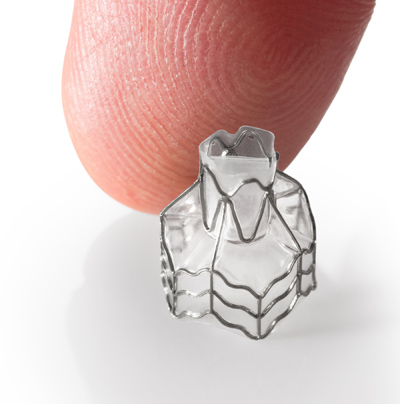by Nancy Humphrey
Life with emphysema, a lung condition that causes shortness of breath, can be miserable. People with advanced emphysema, a form of chronic obstructive pulmonary disease (COPD), are so short of breath they may need supplemental oxygen just to walk from room to room. They often have trouble with everyday tasks like bathing or cooking a meal.

For some affected individuals, lung volume reduction surgery is an option — surgeons remove one or more lobes of the lungs to physically reduce the volume of air in the chest. But that surgery is risky, can involve days in the hospital, and patients often go home with chest tubes.
A new FDA-designated breakthrough medical device — the Pulmonx Zephyr Valve — is a minimally invasive alternative to lung volume reduction surgery. In the procedure, a physician uses a bronchoscope, a small tube with a camera, to place tiny valves in the airways to block off the damaged areas of the lungs so air no longer gets trapped there. No incision is required and the valve placement allows the healthier part of the lungs to expand, relieving pressure on the diaphragm, which decreases shortness of breath and makes breathing easier.
With emphysema, the normally elastic air sacs in the lungs (alveoli) are damaged beyond repair. Over time, the damage gets worse as the inner walls of the air sacs weaken and rupture — creating larger air spaces instead of many small ones and causing the lungs to stay overinflated. This reduces the surface area of the lungs and, in turn, the amount of oxygen that reaches your bloodstream.
“If you have a lung that is physically larger, because air is trapped, its volume is greater,” said Robert Lentz, MD, assistant professor of Medicine in the Division of Allergy, Pulmonary and Critical Care Medicine. “The rib cage is a fixed structure and you can’t increase the size of it … so the diaphragm gets pushed down and works at a mechanical disadvantage, making people really short of breath,” he said. “If we can do something to make the lungs to go back to more of a normal volume, and unload all that extra displacement on the diaphragm, the patient feels quite a bit better.”
The Zephyr Valve occludes the hyperinflated lobe of the lung that is diseased with emphysema. When the lung is occluded properly and isolated from airflow, trapped air in that lobe will escape through the valve until the lobe no longer contains air and shrinks to a fraction of its inflated size. This relieves compression on the remaining lobes and diaphragm, allowing the healthier part of the lung to work more efficiently, improving overall lung function.
Until now, patients with advanced emphysema have only had two options for improvement — lung transplant or the more invasive lung volume reduction surgery, Lentz said.
“The trouble with lung transplant is that you’re trading one disease for another. It’s hard to predict in the emphysema population who will live longer with transplant,” Lentz said. According to the National Heart, Lung and Blood Institute at the National Institutes of Health, a little more than half of single-lung transplant patients survive at least five years after surgery.
And few people in the United States (under 100 a year) opt for lung volume reduction surgery because it’s so invasive. There are also criteria that have to be met before the surgery is an option.
The patients’ upper lobes need to be affected more than lower lobes and patients may not be eligible if there’s a history of coronary disease.
These criteria matter less for the Zephyr Valve, Lentz said, although not everyone evaluated for the procedure at VUMC ends up being a candidate.
One thing that must be determined for treatment with the valve is whether the patient has collateral ventilation, which happens when the fissure structure between the lung lobes is not solid and air can pass through from one lobe to another.
“In order for the procedure to work, the membranes that surround each lobe need to be complete and there can’t be air that leaks between the lobes,” Lentz said.
To determine if that’s the case, patients need to have a detailed CT scan to make sure there is no air leaking from one lobe to another.
Lentz said that most patients who have the valve procedure report improvement in their daily lives. “We look at whether breathing tests improve and whether patients report being able to walk farther and if they feel better — about two-thirds report significant improvement,” he said.
“No one is going to run a marathon after this procedure, and we have discussions about expectations. These are folks who want to walk to their mailbox and back for the first time in five years; walk a flight of stairs; walk down a small slope and back to go fishing at their favorite lake or finish a grocery shopping trip without having to stop five times.
“That’s the kind of improvement we’re looking for, and for patients who for years have not been able to do these very simple things that we all take for granted, that can be very meaningful,” Lentz said.












